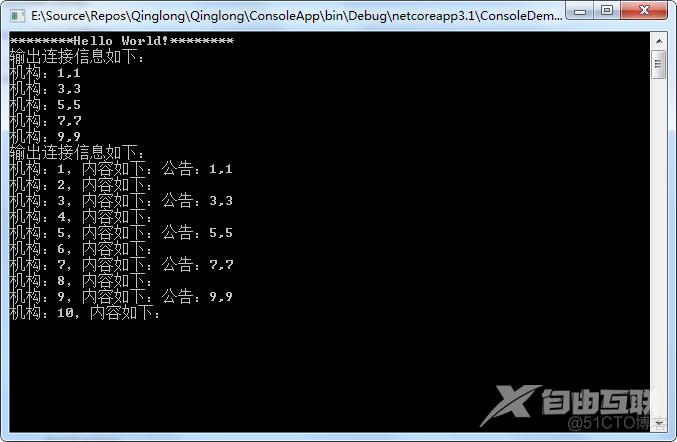C# LINQ中Join与GroupJoin的区别 新建控制台项目ConsoleDemo,添加Testlinq类,代码如下: using System; using System.Collections.Generic; using System.Text; using System.Linq; namespace ConsoleDemo { public class Testlinq {
C# LINQ中Join与GroupJoin的区别
新建控制台项目ConsoleDemo,添加Testlinq类,代码如下:
using System;
using System.Collections.Generic;
using System.Text;
using System.Linq;
namespace ConsoleDemo
{
public class Testlinq
{
private List<UserDepart> userDeparts = new List<UserDepart> { };
private List<NoticeData> noticeDatas = new List<NoticeData> { };
public Testlinq()
{
for (int i = 0; i < 10; i++)
{
userDeparts.Add(new UserDepart { UserId = i + 1, Name = $"机构:{i + 1}", DepartmentId = i + 1 });
if (i % 2 == 0)
{
noticeDatas.Add(new NoticeData { Id = i + 1, Name = $"公告:{i + 1}", DepartmentId = i + 1 });
}
}
}
public void Testjoin()
{
//查询语法
var x = from a in userDeparts
join b in noticeDatas on a.DepartmentId equals b.DepartmentId
select new { name = a.Name, id = a.DepartmentId };
Console.WriteLine("输出连接信息如下:");
foreach (var item in x)
{
Console.WriteLine($"{item.name},{item.id}");
}
//函数语法
//var s = userDeparts.Join(noticeDatas, a => a.DepartmentId, b => b.DepartmentId, (a, b) => new { name = a.Name, id = a.DepartmentId });
//Console.WriteLine("输出连接信息如下:");
//foreach (var item in s)
//{
// Console.WriteLine($"{item.name},{item.id}");
//}
}
public void TestGroupjoin()
{
//查询语法
var y = from a in userDeparts
join b in noticeDatas on a.DepartmentId equals b.DepartmentId
into clist
select new { name = a.Name, list = clist };
Console.WriteLine("输出连接信息如下:");
foreach (var item in y)
{
Console.Write($"{item.name},内容如下:");
foreach (var subitem in item.list)
{
Console.Write($"{subitem.Name},{subitem.DepartmentId}");
}
Console.WriteLine();
}
//函数语法
var s = this.userDeparts.GroupJoin(noticeDatas, a => a.DepartmentId, b => b.DepartmentId, (a, blist) => new { name = a.Name, list = blist });
//Console.WriteLine("输出连接信息如下:");
//foreach (var item in s)
//{
// Console.Write($"{item.name},内容如下:");
// foreach (var subitem in item.list)
// {
// Console.Write($"{subitem.Name},{subitem.DepartmentId}");
// }
// Console.WriteLine();
//}
//从结果来看
//1、GroupJoin 和数据库的 left outer join 一样
//public static IEnumerable<TResult> GroupJoin<TOuter, TInner, TKey, TResult>(this IEnumerable<TOuter> outer, IEnumerable<TInner> inner, Func<TOuter, TKey> outerKeySelector, Func<TInner, TKey> innerKeySelector, Func<TOuter, IEnumerable<TInner>, TResult> resultSelector)
//2、Func<TOuter, IEnumerable<TInner>, TResult> resultSelector 也就是 GroupJoin中的(a, blist) blist类型是 IEnumerable<TInner>
}
}
public class UserDepart
{
public long UserId { get; set; }
public long DepartmentId { get; set; }
public string Name { get; set; }
}
public class NoticeData
{
public long Id { get; set; }
public long DepartmentId { get; set; }
public string Name { get; set; }
}
}
控制台项目ConsoleDemo的Program添加 如下:
Testlinq testlinq = new Testlinq();
testlinq.Testjoin();
testlinq.TestGroupjoin();
运行结果:

龙腾一族至尊龙骑
